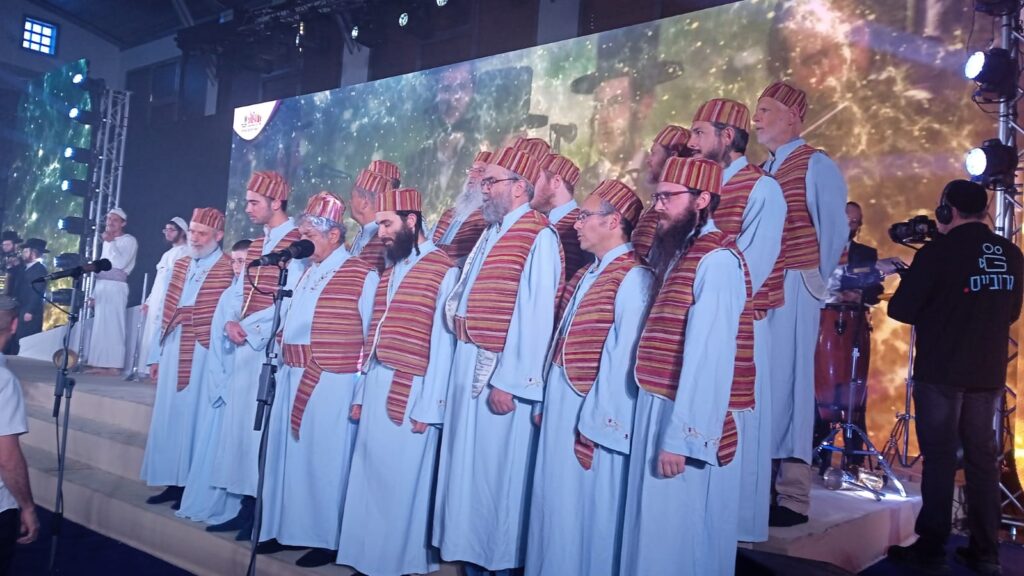On Tuesday, a Korban Pesach (Passover offering) was held in Romema, Jerusalem. While this is an annual occurrence, it is usually treated in the media as a gathering of fringe lunatics inciting Arab violence with little or no connection to Torah and Judaism. This year was decidedly different, with over 500 people attending an event sponsored and organized by the Jerusalem municipality. A fantastic but little-known back story explains the growing enthusiasm for this pre–Messiah event.
Every year before Passover, the Temple movements organize a full-dress practice of the Passover offering, which usually includes an actual lamb slaughtering. The practice is intended to work out any practical details involved in the Temple ritual and to raise awareness of the need to revive the Temple service. A lamb was slaughtered in advance and its proper use in the Temple service was demonstrated. This year, the reenactment included, for the first time, musical accompaniment by a corps of Levites. Young Kohanim (Jews descended from Aaron the High Priest) played a prominent role in the reenactment as part of their training for the Third Temple.

Attendance for the annual event has steadily risen, though no reenactments occurred during COVID shutdowns. Every year, the Israeli police arrest any Jew bringing a lamb to Jerusalem on charges of disturbing the public order and incitement. This contravenes Israeli laws which protect freedom of religious expression. However, the police have been increasingly supportive of the reenactment.
Rabbi Meir HaLevy, a member of the Sanhedrin and a Levite who participated in the reenactment, explained that a little-known story about the origins of the reenactment may explain why.
“Eighteen years ago, we created a cornerstone for the Third Temple,” Rabbi HaLevy explained. “The High Court rejected our appeal to bring the cornerstone to the Temple Mount or to even march around the Temple Mount with the stone, manifesting the prophecy of “the stone that is rejected by the builders’ (Psalms 118:22) but we caught the attention of the Shin Bet (Israel’s internal security service). They were surprisingly supportive and enthusiastic. But they told us that if we wanted to take it further and bring a Korban Pesach, we would need permission from the Israeli police.”
“We had a meeting with a large group of police officers who asked us why we wanted to do a Korban Pesach, and we explained that this is what God commanded us to do at Mount Sinai, and the teachings have been handed down for thousands of years. The Passover offering may only be brought in one place, where the altar stood in the Temples, and for 2,000 years, we were prevented by the Muslims, Christians, and Ottomans. Still, now that we have a Jewish state, we wanted to perform the Passover offering.”
“The police explained that bringing an offering on the Temple Mount would lead to Palestinian violence, so they could not permit it. But they asked what the implications were for not bringing the Passover offering. I explained that the Torah stated explicitly that a Jew who does not bring the Korban Pesach is punished with karet, the removal of divine providence and protection. But since it was the police who were preventing Israel, the punishment was on them.”
“This disturbed the police greatly, as going in harm’s way without divine protection was daunting, similar to being in a firefight with a bulletproof vest. They passed it onto the High Court, which ruled against us. The media got wind of this and assumed that the court would approve the request, as Israel is purported to be the Jewish state with freedom of religion. So when the 14th of Nisan arrived, the international media were on the Temple Mount to report on the epic event, but it never happened.”
Rabbi Halevy declined to speculate whether the current difficulties surrounding the Israeli judicial system were due to its opposition to the Passover offering.
“Before Passover, the police agreed to a reenactment in an alternative location, which has occurred every year since,” Rabbi HaLevy explained. “The police have always been supportive and the Jerusalem Municipality hosted the event this year.”
The practice is making a comeback. Last week, Rabbi Shmuel Eliyahu, the Chief Rabbi of Tzfat and a prominent religious leader, gave a lesson about the mitzvah, which included a practical demonstration involving an actual lamb that had been slaughtered in advance. In his lesson, Rabbi Eliyahu ruled that we must bring the Passover offering even while we lack the Temple and the ashes of the Red Heifer for purification.
However, not everyone is so supportive of reviving the Temple service. Hamas’ official media outlets issued statements via the terrorist group’s Telegram channel, reiterating Islamic teachings stating that the entire area of the Temple Mount is “an indivisible component of the Al-Aqsa Mosque (the black domed mosque on the southern end of Judaism’s holiest site).”
“Any Jewish presence or religious observance at the site is a profound breach of the sanctity of the location,” the Hamas message read, specifying practices such as blowing the shofar (ram’s horn) on Rosh HaShanna, waving a lulav (palm branch) on Sukkot.
Hamas warned against bringing a symbolic Passover offering as it would “symbolically transform Al-Aqsa into a Temple,” thus laying the groundwork for what they described as a broader plan to construct the Third Beis Hamikdash.
Hamas warned against separating designated prayer areas for each religion as was done at the Cave of the Patriarchs in Hebron, as it was the prelude to actual construction.
Like the Cave of the Patriarchs, Israel conquered the Temple Mount in the 1967 Six-Day War.




